- Joined
- Oct 9, 2020
- Messages
- 1,849
- Points
- 488

Can someone pls tell me what the purpose of the catharpins? They are the most frustrating thing to put on and I am debating whether I will install them or not.
tks
tks



no those are catharpins as well. Apparently some ships had them down there too.I think Catharpins are used on the fore and main mid and upper shrouds and are used to secure the mid and upper shrouds to the mast so that the yards had more freedom of movement- otherwise they would have to run down to the deck like the lower shrouds….. what you have depicted are not catharpins I don’t think…. They are on the lower shrouds and I don’t know what those are or their purpose…. But I could be wrong….
Is this what you mean ?Can someone pls tell me what the purpose of the catharpins? They are the most frustrating thing to put on and I am debating whether I will install them or not.
tks

The top image, yes. Your image refers to them as cat-harpings, but that is the same thing. ThanksIs this what you mean ?
Sorry, I've forgotten the source.The top image, yes. Your image refers to them as cat-harpings, but that is the same thing. Thanks

thank youSorry, I've forgotten the source.

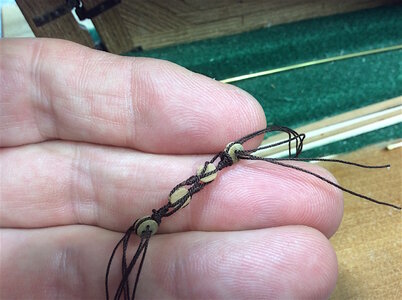
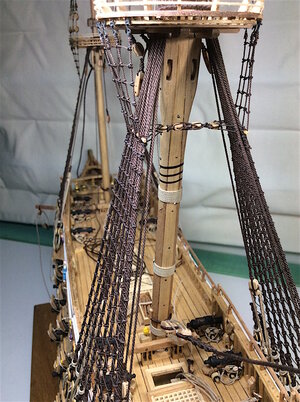
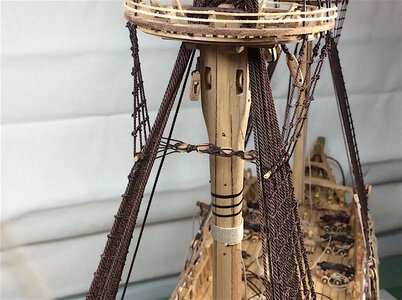
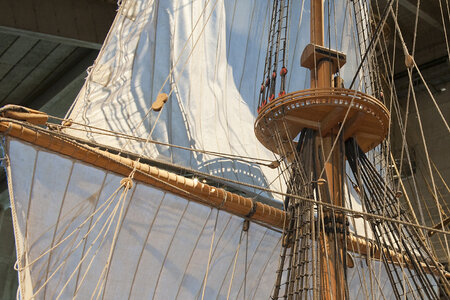

Thank you for this information. Quite technical isn't it...Definition from "The Art Of Rigging" by George Biddlecombe. Originally published in 1925 for use by midshipmen at the US Naval Academy.
"CATHARPINS.-Short ropes, to keep the lower shrouds in tight, after they are braced in by swifters; and to afford room to brace the yards sharp up."
You can see them illustrated in the photo above.
What, might you ask, is/are "Swifters"?... More definitions from the same book:
"SWIFTERS are the aftermost shrouds on each side of the lower masts; they are above all the other shrouds, and are never confined to the catharpins"
"SWIFTERING of SHROUDS- stretching them by tackles, to prevent any further extension; - only done in bad weather."
Phew.......that cleared things up...not.

Here are some pages from another book. The jpg is the cover. The pages are PDF. Not sure how this will work. I'm sure you will need Adobe Reader to open them. Be sure the size is 100% and if they are sideways click on the "View" menu and then "Rotate clockwise". That should make them readable and in "Scan 0002" you can scroll thu the 3 pages. This is the book you need for your 'Vasa" model [Edit.... I open the PDF and the image was sideways, but there is a "Rotate button" the puts it "right side up"]Coastie,
That is correct - I also had no idea about these - but wanted to add them to my Vasa (only main mast) - I used the museum's 1/10th as a guide - in retrospect I think that I did them wrong. Here are a "couple" of images.
When I visited the museum in 018 spent a great hour with Dr. Fred Hocker - he mentioned that for their 1/10th they incorporated English rigging in their model as well as what they knew about Dutch rigging of that period. Last image is obviously the 1/10th
View attachment 266025View attachment 266026View attachment 266027View attachment 266028

Thank youHere are some pages from another book. The jpg is the cover. The pages are PDF. Not sure how this will work. I'm sure you will need Adobe Reader to open them. Be sure the size is 100% and if they are sideways click on the "View" menu and then "Rotate clockwise". That should make them readable and in "Scan 0002" you can scroll thu the 3 pages. This is the book you need for your 'Vasa" model [Edit.... I open the PDF and the image was sideways, but there is a "Rotate button" the puts it "right side up"]
Here's a pic of my Constellation from many moons ago. I don't think the plans called for catharpins but had a rope from each futtock shroud stave to a tackle on the deck for the same purpose....to pull in the shrouds in order to allow the yard to swing forward or aft without chafing the shroudsPrevious comments nailed what catharpins are…simply short ropes or iron clamps used to brace in the shrouds toward the masts so as to give a freer sweep to the yards. Many catharpins are seized or clamped directly to the shrouds without blocks…especially in the later years of their use. Of all the period models I built with catharpins non had block and tackle assemblies.
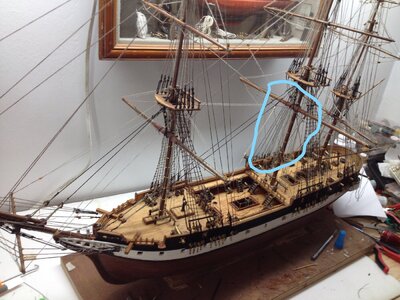

Thanks. Certainly puts things into perspective.Catharpins are not for helping to brace in the yards. The shrouds do not move more than a few inches when the catharpins are functioning. What the catharpins do is equalize and shift the tension in the shrouds from one side to the other as the ship heels. Masts move, bend and flex (the rope shrouds also stretch) in heeling; they are not inflexible poles. The shrouds vary in tension as the masts move; mostly about one-third of the way up from the deck. If the shroud tension is too little or too great, the forces in the masts can exceed the breaking point of the wood and the masts can "spring". This kind of damage (if not too great) can be repaired with a "fish" which will hopefully allow the ship to sail to a safe haven for more substantial repairs. The catharpin system looks simple and of no practical use, but, many dismastings, sinkings and lives lost were caused by crews/captains that did not fully appreciate the catharpins use and value. As a practical matter, every ship with rope shrouds could have used catharpins; although I doubt that was the case. The catharpin system was a very practical application of the principles of physics.
